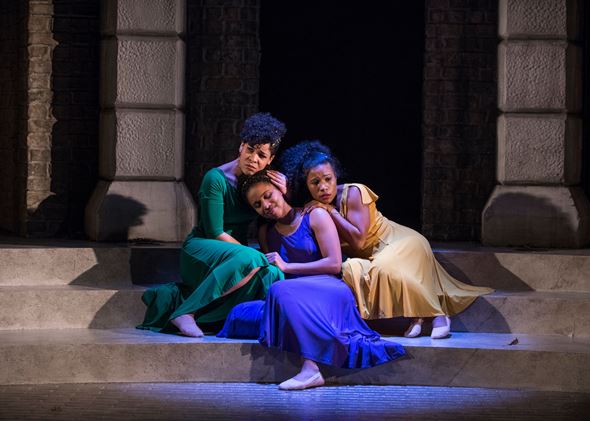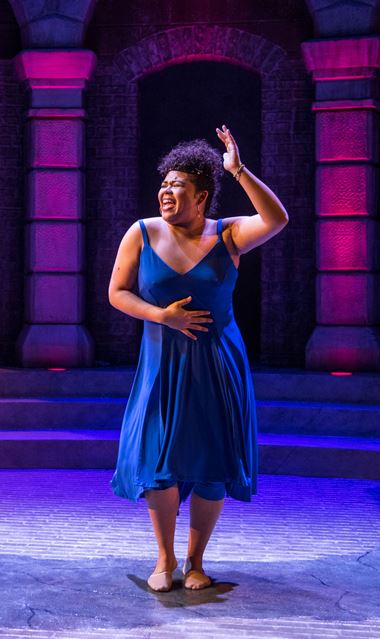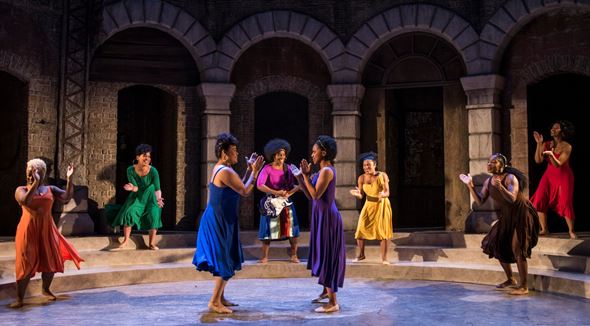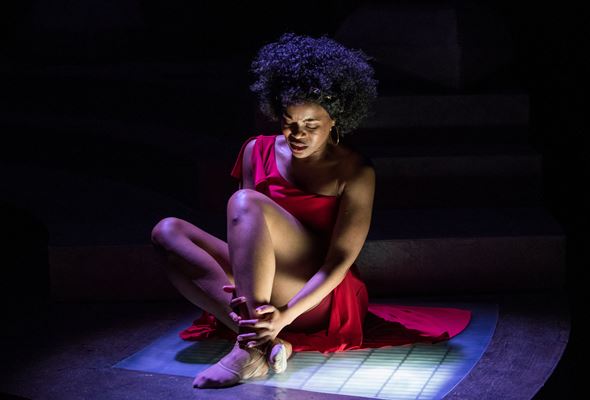‘For Colored Girls’ at Court: Getting through hard lives with a distant promise of rainbows

Dressed in the hues of rainbow-yearning: the Lady in Green (Angelica Katie), the Lady in Blue (Melissa DuPrey), the Lady in Yellow (Melanie Brezill). (Production photos by Michael Brosilow)
“For Colored Girls Who Have Considered Suicide When the Rainbow Is Enuf” by Ntozake Shange, at Court Theatre thru April 14. ★★★★★
By Lawrence B. Johnson
You have half a dozen more chances to see Ntozake Shange’s stunning play “For Colored Girls Who Have Considered Suicide When the Rainbow is Enuf” before it closes April 14 at Court Theatre. That is, assuming a seat opens up; the remainder of the run is sold out. No surprise there. “For Colored Girls” is a theatrical experience of authentic soul and rare beauty.
Shange, who died last year at age 70, called her singular 1976 play a choreopoem: It’s written for a singer-narrator and seven actresses who enact 20 scenes in voice and movement dealing with the lifelong vicissitudes of women of color. Shange’s prose-poetry is direct, lyrical, vivid and affecting. And Court’s staging, directed by Seret Scott, boasts a parade of superb actresses who capture the space between suicide and rainbows in all its passion, humor, grit and pathos.
The characters don’t have names. They represent Everywoman – that is, every colored woman. But they do bear rainbow-like sobriquets, with dresses to match: The Lady in Red, the Lady in Blue, the Lady in Orange, the Lady in Brown, the Lady in Green, the Lady in Purple, the Lady in Yellow. At the beginning of the play, each character checks in from a different urban center around the country. Yet, place seems incidental. These are shared stories, common circumstances, universal truths.
That universality, and with it an underlying sense of it was ever thus, is underscored by designer Courtney O’Neill’s vaguely ancient backdrop of stone archways that open onto a wide performing space. Costumer Samantha C. Jones’ richly hued dresses, Paul Toben’s dramatic lighting and Leah Casey’s eloquent and witty choreography make essential contributions to the marvelous sum of this enterprise.
But, to be sure, it is the splendid cast that brings off Shange’s penetrating and mesmerizing testimonies of life as it unfolds for colored girls.
Somewhere close to the centerpoint of that spectrum falls Melissa DePrey’s sensual, good-timey but ever so droll monologue as the Lady in Blue, who loves salsa dancing. The sweet life for the Lady in Blue is dance marathons and blues clubs. There’s as much conviction in her easy movement as in her candid speech.
The Lady in Yellow (Melanie Brezill) recalls being the only virgin in her senior class on graduation night. That issue is resolved before the sun rises, in the back seat of a Buick. The Lady in Brown (Patrese D. McClain) has quite a different memory from her youth, actually as a little girl: She won a reading contest for colored girls – but was disqualified because her selections all came from the adult section of the library. There’s a delicious subplot to this tale that I wouldn’t think of spoiling.
Such light-hearted stories as these relieve the pain of others. Rape is a major theme. DuPrey’s Lady in Blue joins the Ladies in Purple (Leah Casey) and Red (AnJi White) in a chilling, matter-of-fact rumination on assault by the nicest guys, the easy-going sweet-talkers who turn out to be monsters. Do you go to the cops? Forget the cops. Besides, the whole world thinks this jerk is great. What was your part in what happened? What were you wearing?
More sardonic than funny is a screed by the Lady in Green (Angelica Katie) on how somebody (a man) has taken all of her “stuff.” She means material things, but more than that, her essence – her rhythm, her voice. And the worst part of it is that he doesn’t even know he has it. Anyway, she wants her stuff back.
A cluster of the ladies converge on the familiar, all-purpose dodge of “sorry.” Guys seem to think they can pull just anything, then make it all OK with a self-exonerating “I’m sorry.” One lady declares that from now on, she’s not accepting any more useless apologies. When a guy’s behavior is outrageous, she’s going to respond in kind – by screaming and breaking things. With no apologies.
If there’s a star in this splendid ensemble, it is AnJi White, the Lady in Red. She does a poignant turn as a creature of the night who acts out a fantasy role, providing what the men want, then crashing down to her own reality – night after night. But the real crusher is White’s extended narrative as the paramour of a loser and mother of his two small children. He’s demanding that she marry him; she wants none of it. Then he plays a card she doesn’t know he’s holding, and it is horrific.
The flow of stories and the shifting mixes of ladies bespeak Scott’s sure-handed direction. But the sense of coherence in this nonlinear play is also strengthened by the Homeric performance of Melody Angel as Lyric – versatile commentator-cum-accompanist as singer, guitarist and drummer.
While complicated logistics prevent Court from extending “For Colored Girls,” it well might be revisited in the next few seasons. The sooner the better.
Related Link:
- Performance location, dates and times: Details at TheatreInChicago.com




